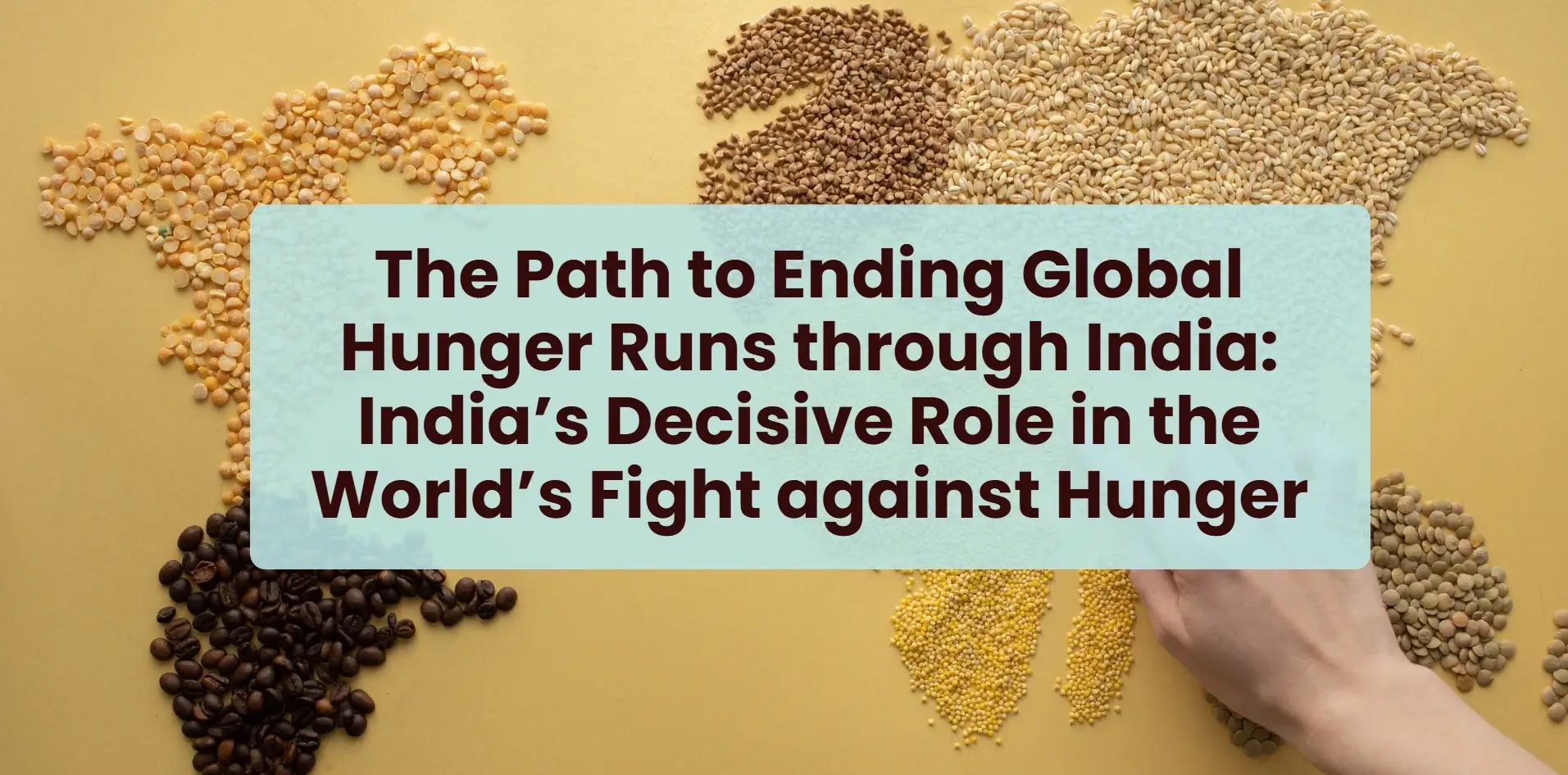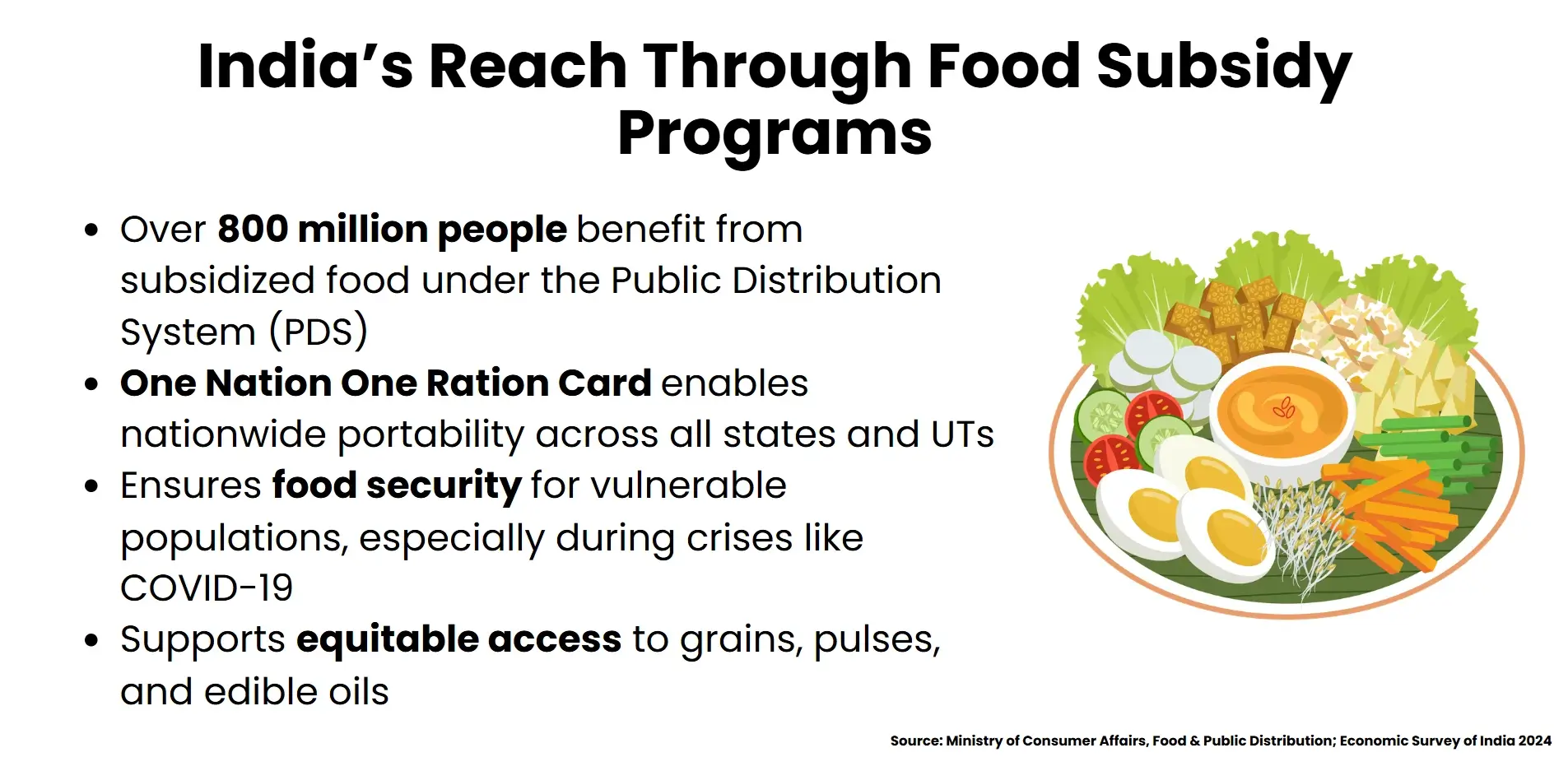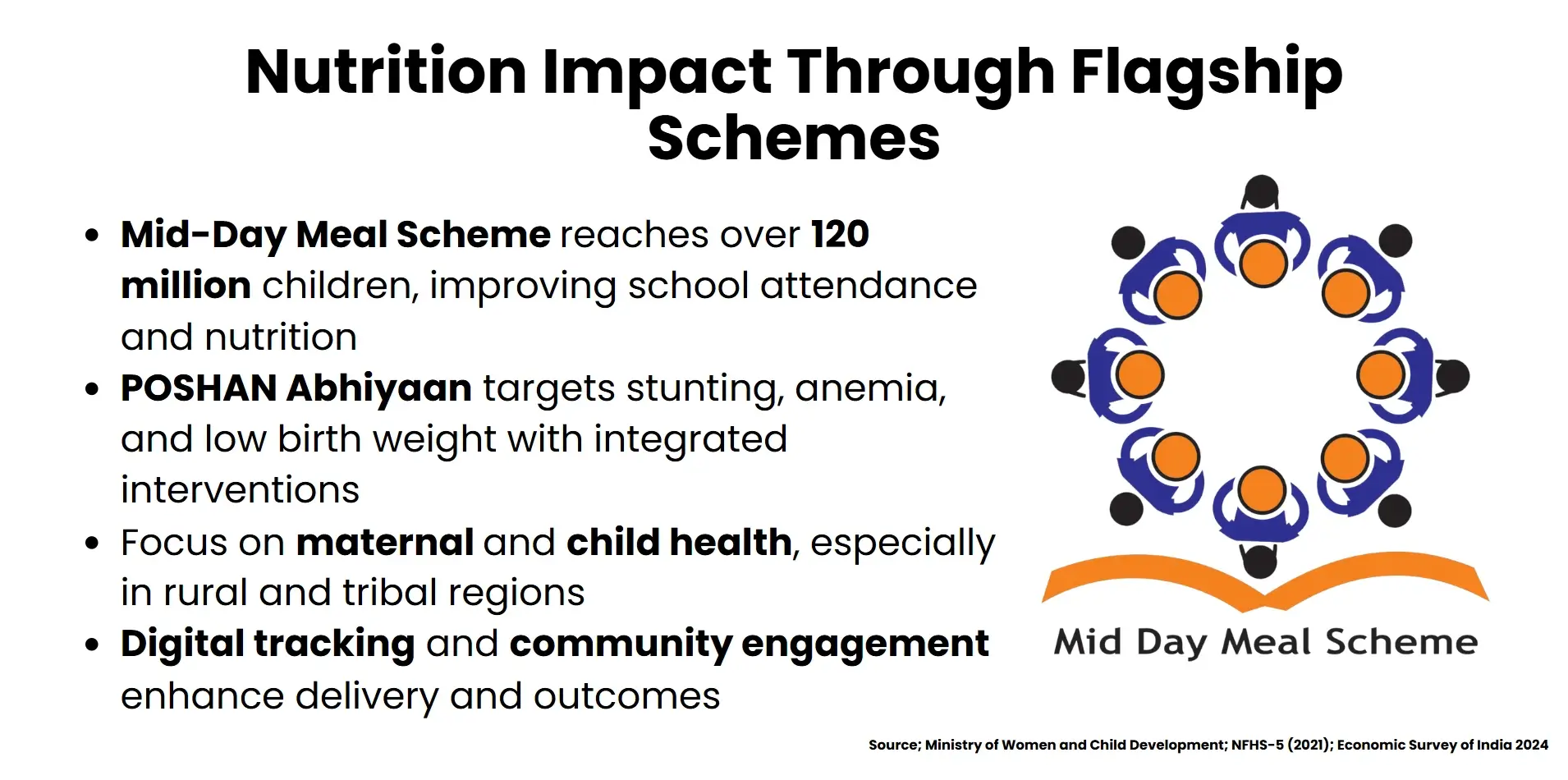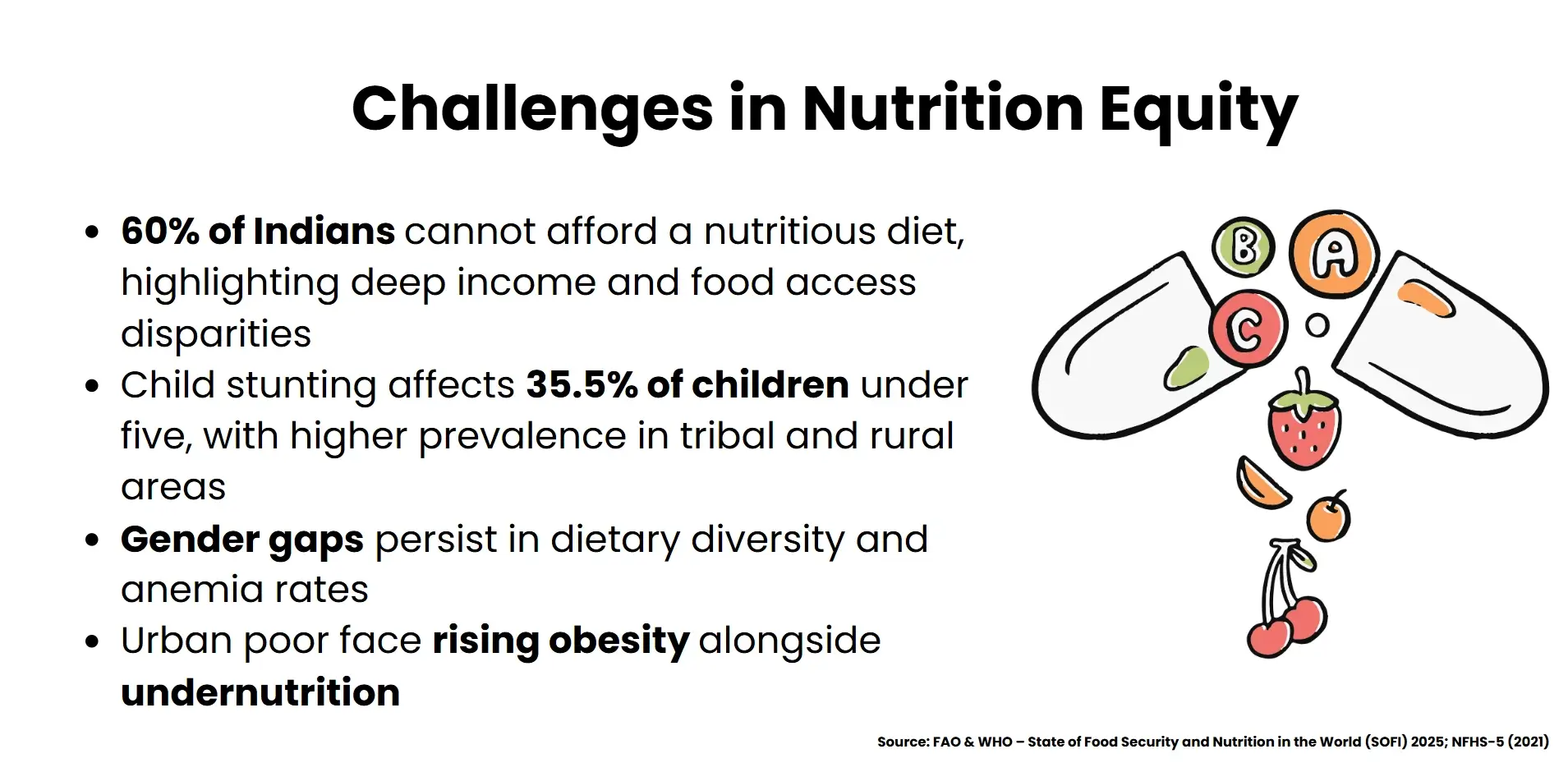The strategic policies India employs to address food security, nutrition, and agriculture make the country a leader in the global quest to eliminate hunger.By using digital technologies and better governance, India has made major policy investments in food security and nutrition, making an important contribution to global development. India's undernourishment rate decreased from 14.3% in 2020–22 to 12% in 2022–24, leading to 30 million fewer hungry people.

The Path to Ending Global Hunger Runs Through India
Hunger is one of the most urgent problems in the world today that leaving more than 700 million people in search of food and negatively impacting sustainable development. With food insecurity worsened by changing climate, war, and economic upheavals all over the world, India is proving to be a pivotal actor capable of defining solutions that are scalable and inclusive. India has the experience of decades of policy experimentation with its large population and varied agriculture and today it has become a major contributor towards global food security and nutrition.Such a change is not an accident but rather an effect of systematic investments in the public well-being programs, nutrition programs, and agricultural innovation. The case of India lies in the Public Distribution System, Mid-Day Meal Scheme, the POSHAN Abhiyaan and climate-resilient farming schemes thatcombinetechnology, government, and the involvement of grassroots movements. In addition, Indian initiative in South-South cooperation and its stature at international forums such as the UN Food Systems Summit are indicative of its increasing coffers in global hunger abolition approaches.This article examines how the policy architecture of India, institutional capabilities and global involvementput the country atthe pivot in efforts to combat hunger. Nations striving to find models which lead to a coexistence of equity and efficiency can take inspiration and practical lessons to learn how to make a hunger-free world in and through the experience of India.
Past struggles and change in India
The process that is seen as India moving out of chronic food insecurity to one of global contributor in reducing hunger emerges as a deep structural transformation, technological breakthroughs, and equity-based policy innovations.
Post-Independence Food Crisis and Institutional Response
The years immediately after independence had been marked with acute shortages of food, frequent famines, and overdependence on imported food. The food crisis in Bengal in the year 1943 and later occurrences of droughts revealed the weaknesses of the Indian agrarian economy. To respond to this, a set of institutionswas created by the government, including the Food Corporation of India (1965), and the process of buffer stock mechanisms was introduced to maintain supply and prices. These pioneering measures were important in establishing food security measures in the future.
The Green Revolution
A breakthrough came in the 1960s with the Green Revolution, with high-yielding seed types of wheat and rice, chemical fertilizer, and waterworks. Under the leadership of scientists like M.S. Swaminathan, the movement transformed India from a food-deficient nation to one that produces an abundance of grains. Punjab, Haryana and western Uttar Pradesh turned into hotspots of this change, but subsequent lop-sidedness and environmental burdens became evident.
The Evolution of Policy to Inclusive Food Security
By the 1990s and 2000s, India was not only focusing on marginal production, but they were also focusing on inclusion. The Public Distribution System (PDS) was enlarged and put on computerization and nutrition-specific programs such as the Mid-Day Meal Scheme (1995) and the Integrated Child Development Services (ICDS) emerged. These programs were aimed at vulnerable groups of the population,primarily children and women, and this was a shift to nutrition equity rather than food availability.

Policies that are flagging towards Food Security
Apparent in the Indian experience is its food security strategy that builds on a package of ambitious, rights-informed policies and aimed at securing availability and access to food, and the vulnerable populations in both settings, the rural and urban environments.
Public Distribution System (PDS)
With over 800 million people receiving subsidized grains, the PDS is the backbone of food access in India. Digitization, biometrics through Aadhaar and transfers becoming portable through the One Nation One Ration Card scheme in the last few years are removing leakages and enhancing transparency. The above innovations guarantee that marginalized groups and migrant workers have access to entitlements that can cross state boundaries.
Mid-Day Meal Scheme and ICDS
The Mid-Day Meal Scheme was started in 1995 to deliver cooked food to the children in school, improving their nutrition and increasing school attendance. To supplement this, the Integrated Child Development Services (ICDS) provides addition nutrition, immunization, and early levels of education to children below the age of six years, as well as pregnant women. Collectively, these programs solve intergenerational malnutrition and encourage human capital growth.
POSHAN Abhiyaan
Health, sanitation, and nutrition are united in a multi-sectoral approach to the flagship nutrition mission in India by POSHAN Abhiyaan (2018). It capitalizes on real-time data dashboards, community mobilization, and behaviour change campaigns in order to curb stunting, anemia, and low birth weight. Jan Andolan movement under POSHAN promotes participation at the grassroots levels, which makes nutrition a mass responsibility.

These policies signify India's shift from distributing food to managing overall nutrition. Through the integration of the areas of technology, decentralization, and rights-based entitlements, India has provided a paradigm of inclusive food security that may be copied in the Global South.
The Indian Agricultural Resilience and Innovations on Climate changes
The ongoing transformation of Indian agriculture is characterized by climate-smart practices, technological innovations, and an inclusive model that enhances smallholders' access to opportunities and power, while addressing ecological vulnerabilities and ensuring food system sustainability.
Enhancing Millets and Climate-Smart Crops
India is turning its exploration of millets (which arenutritious) anddrought-tolerant crops, in response to a renewed interest in climate-resistant agriculture. Proclaiming the world leader in 2023, as the International Year of Millets, India has developed procurement incentives, awareness campaigns, and the incorporation of the crops into their public nutrition programs. Millets need less water, grow on poor soil, and provide an alternative to unsustainable water-thirsty crops such as rice and wheat.
Empowering Women farmers and smallholders
Since the majority i.e. 85% of Indian farmers work on small farms, current policy efforts increasingly focus on low-cost and decentralized innovation. Policies such as PM-KISAN and the National Mission on Sustainable Agriculture provide assistance to soil health, organic farming and water-use-efficiency. Women-led Self Help Groups and Farmer Producer Organizations (FPOs) are coming to the fore in agri-value chains, boosting productivity as well as equity.
Making use of Agri-Tech and digital tools
The agri-tech sector in India is thriving as startups have launched services that use AI to provide crop advice, precision irrigation, and access to markets via mobile phones. E-markets such as eNAM (National Agriculture Market) and Kisan Call Centres give equal access to information and minimize the intermediaries. Drone cameras are already deployed to get a view of crops and estimate their yields; meanwhile, the IoT sensors are also applicable to observe crop health and yield ability.
Resilience in its agricultural sector is due to the fact that India manages to remain traditional as well as innovative. Through a scaled-up intervention in climate-smart practices and digital tools, India is not only in a position to ensure domestic food security but also help solve the hunger issue at a global scale.
Leading the World and South-South Cooperation
India remains committed to global food security not only domestically but also through its ambitious strategic diplomacy and humanitarian aid, as well as through the knowledge-sharing that it extends to other developing countries in the Global South.
Leading in multilateral forums
India has become the chief promoter of equitable food systems in international fora like the UN Food Systems Summit, the Committee on World Food Security (CFS), and the World Trade Organization (WTO). It continually upholds the concerns of low-income nations, in terms of the requirements of inclusive agricultural trade, climate adaptation and transfer of technology. India has led global efforts through initiatives focused on food stockholding and nutrition-sensitive agricultural proposals.
Sharing best Practices with the Global South
Development assistance by India to other countries in the regions of Africa, Southeast Asia and Latin Americais rooted in a strong South-South agenda. India offers training in soft skills development, nutrition planning, common good planning, and sustainable agriculture through the Indian Technical and Economic Cooperation (ITEC) program. It has initiatives such as the India-Africa Institute of Agriculture and Rural Development (IAIARD) in Malawi, which is an initiative that demonstrates its involvement in capacity-building and empowerment of the grassroots.
Humanitarian Assistance and Pandemic Diplomacy
India has provided food relief and medical supplies to more than 150 countries during the COVID-19 global pandemic, cementing the reputation of the country as a credible partner in times of crisis. India has an ethos of humanitarianism as part of under Vaccine Maitri initiative and emergency delivery of food supply to famine or war-torn countries. This helped India to emerge as a strategic partner in resilience.
India has been leading in South-South cooperation based on solidarity, and not charity. Combining both domestic prosperity and international responsibility, India is creating a more nutritious and healthy world order.
Challenges and the way ahead
Becoming the world hunger solutionis an opportunity, but it has challenges too. Despite its developments, structural impediments and needs of the future are imminent, multi-inclusive and innovative.

Persistent Under-nutrition and Inequality
India is still faced with severe cases of hunger in spite of the economic growth and agricultural surpluses. The Global Hunger Index noted that there is undernourishment, wasting, and child stunting, mostly among the marginalized populations. Regional Disparities and nutritional gaps by gender, and a lack of dietary diversity hinder progress. Serious disparities are evident in the fact that over 60% of Indians cannot afford a nutritious diet.
Bottlenecks in the Infrastructure and Food Systems
Poor logistics, lack of enough cold storage facilities and disregarded supply chains, eliminate up to 13% of the Indian food between farmsand market. Such inefficiencies not only decrease availability, but increase costs of nutrient rich foods, as well. Climate change also contributes to vulnerabilities, as rain falls unpredictably and continuous increase in temperature is putting crops at risk and causing farmer incomes to drop.
Innovation, Reform of Policies, and International Cooperation
India needs to invest in climate-proof agriculture and nutrition-sensitive public programs, as well as in online food distribution systems, to turn into a mere hunger solution center. Hidden hunger and micronutrient deficiency can be resolved by the inclusion of millets, pulses, and fortified foods in the Public Distribution System (PDS). India has been exemplary in the development of exclusive breastfeeding as well as community nutrition initiatives that can be used elsewhere by other countries.
Road Ahead
India has not yet come far. With its startling population growth of 1.7 billion people by 2050, the food security of nations with limited access to food will increasingly rely on its performance. It is crucial to have global solidarity, invest in sustainable technologies, and share the knowledge. The achievement in India should turn to a common blue model where equity crosses paths with innovation, and where hunger remains in the past.
Conclusion
The story of how India turned into a global food security giant, despite being a country ravaged by famine in previous decades, is the legacy of wise policy-making, high falls in agricultural technology, and all nutrition initiatives in this country. Having saved not only its people but also becoming an example to the Global South through the way it has kept hunger at bay, India has gone through several waves of these changing scenarios, one of which is the Green Revolution, and the other is POSHAN Abhiyaan. With its size, institutional capability, and adherence to rights-based welfare, it is centrally involved in global messages seeking to eliminate hunger.With climate change, conflict, and inequality under pressure onfood systems globally, the case of India can provide practical solutions and serve as a moral compass. The future requires greater than national prosperity: it requires global cooperation, ongoing support of sustainable agriculture, and free flow of knowledge and technology.